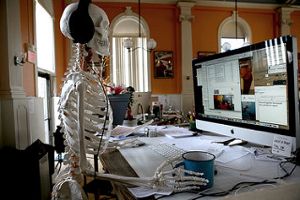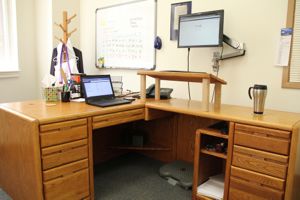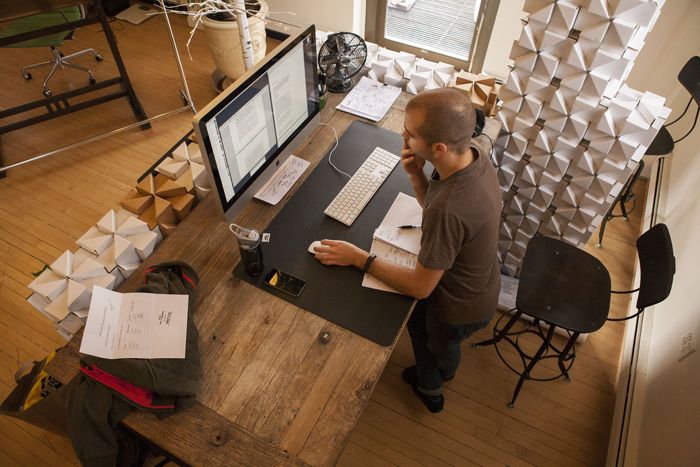I now use a standing desk in my writing business.
After researching the dangers of sitting for hours (over six hours increases your risk of, um…death), and looking into the options that are out there today for standing desks, I convinced myself I needed to make a change.
I didn’t invest in one of those cool standing desks. Instead, I’m using a simple monitor and keyboard booster that cost a lot less but work just fine. They help get me out of the chair for about half my day.
I’ve noticed the difference. I don’t feel so beat up (physically) at the end of the day, and my spine is definitely happier with the arrangement.
So imagine my surprise when I read this headline:
“Sitting for long periods is no worse for your health than standing, study claims.”
Huh? How could that be?
Were Scientists Wrong About Sitting Being the New Smoking?
Because of recent research, we now know that sitting not only increases your risk of premature death, but also your risk of weight gain, back pain, diabetes, cardiovascular disease, and more. It’s so serious that experts have started saying that “sitting is the new smoking.”
But a recent study seems to have contradicted these findings. Researchers examined information on weekly sitting time from 3,720 men and 1,412 women who were free from cardiovascular disease at the start of the study. The data included things like how long the participants sat at work, during leisure time, while watching television, and combinations of these.
Scientists then compared that data with information on the participants’ health, including when they died, over a period of about 15 years.
Results showed no correlations between any of the sitting times and mortality risk.
“Sitting time was not associated with all-cause mortality risk,” the researchers concluded. “The results of this study suggest that policy makers and clinicians should be cautious about placing emphasis on sitting behavior as a risk factor for mortality that is distinct from the effect of physical activity.”
Seriously?
 Standing Desk Research: What About All Those Studies Showing Sitting Increases Risk of Death?
Standing Desk Research: What About All Those Studies Showing Sitting Increases Risk of Death?
Turns out this is one study among many, and it’s in the minority.
Most research so far has shown that sitting does increase risk of disease and mortality.
A 2009 study, for example, found that sitting time was associated with all causes of death, and as people sat 50 percent or more each day, the risk of death from any cause increased 11 to 54 percent.
A 2010 study by the American Cancer Society (ACS) reported that time spent sitting was associated with mortality. More specifically, women who reported sitting more than six hours per day were 37 percent more likely to die during the study period than those who sat fewer than three hours a day—men were 18 percent more likely to die.
And a 2013 meta-analysis of six studies involving data from nearly 600,000 people also reported that higher amounts of sitting were associated with a greater risk of all-cause mortality.
So why the differing results with this more recent study?
Sitting for Long Periods is Still Dangerous—Would a Standing Desk Help?
There may be a couple explanations. The participants were office workers in London—a city where people are known to walk a lot and stand on public transport to get to the office in the first place. In fact, the average walking time for these participants was over double the reported average in the United Kingdom.
And walking is extremely good for you, especially if you’re doing it most every day. Other studies have found that daily walking actually reduces your risk of mortality. The fact that these participants were doing a lot of it may have counteracted the effects of their sitting time.
That may explain the difference there. So far, health experts still agree that sitting for hours at a time is extremely dangerous.
But then I found another issue.
Could it be that our coveted standing desks aren’t really helping?
 Standing Desks Don’t Help Reduce Negative Effects of Sitting
Standing Desks Don’t Help Reduce Negative Effects of Sitting
A study that came out just in March of this year (2016) reported that so far, standing desks aren’t helping to counteract the negative effects of sitting.
The researchers in this new study (published in the Cochrane Database of Systematic Reviews) agreed that sitting increases risk of all kinds of problems, including heart failure and disability, and that it increases risk of overall mortality.
They wanted to know if standing desks and other workplace adjustments made any difference, so they looked at the results of 20 studies involving about 2,700 participants (not a large number).
In these studies, researchers looked at the effects of standing desks, treadmill desks, pedaling workstations, walk breaks, computer prompts that encouraged workers to stand up, and counseling on mindfulness and other health techniques.
Results showed that standing desks and treadmill desks, more than any of the other options, reduced total sitting time at the office.
Standing Desks Reduce Sitting—But Not Overall Health Issues?
Unfortunately, that reduced sitting time did not make any significant health differences over a period of 12 months.
In other words, all those changes didn’t seem to matter.
The researchers were the first to admit that many of the studies they reviewed—among the only ones available so far—were poorly designed, and had very few participants, and that more research is needed to assess the effectiveness of different types of interventions for decreasing sitting time.
So considering the conflict of evidence that we have so far, what are we to think?
Do standing desks help, or not?
 Why I’ll Keep Using My Standing Desk in My Home Office
Why I’ll Keep Using My Standing Desk in My Home Office
In my opinion, based on the research so far and on my personal experience, there are several reasons why you want to hold onto your standing desk (or make/get one soon, if you haven’t).
First, it’s better for your back to alternate sitting with standing. Most of the studies above looked strictly at sitting time and mortality, but sitting causes a lot of problems for the spine. For one, it increases pressure on your spine exponentially over standing. Standing up helps relieve that pressure.
Secondly, it can be much better for your neck and shoulders, too. When we’re sitting at the computer, we tend to hunch over. (Read more about hunchback here.) That’s horrible for the upper spine, and can result in permanent changes in our posture, say nothing of the pain and potential pinched nerves.
For me, standing naturally improves my posture. Of course, if you’re still hunching while standing, it won’t help much, so it’s important to remember posture no matter which position you choose.
So far, research tells us that combining the two—sitting and standing—is best, because standing all day can come with its own set of risk factors (including another type of back pain and potential vascular issues).
“If what you’re doing is replacing sitting with standing, you’re not actually doing your body any favors,” Alan Hedge, a professor in the Department of Design and Environment Analysis at Cornell University, told US News. “In fact, you’re introducing a whole variety of new risk factors.”
At the end of the day, what’s important is that one additional thing we need to add.
Movement.
Standing Desk Or Not: We All Have to Move More
We need to move. From sitting to standing. From standing to sitting. And anything else we can think of.
Because so far, despite all the conflicting evidence, there is one thing we know for sure:
The more we move, the healthier we are.
I have found that when I’m standing up, I’m much more likely to move while I’m working. I tend to shift weight from one foot to the other, dance a bit when a good song comes on, stretch when I need to, and walk around more frequently.
It’s kind of like that Newton’s Law thing: a body in motion tends to stay in motion.
It’s just easier to move more when you’re already up.
And according to researchers, movement throughout the day is key to our health. In a 2015 study, scientists reported that taking 10 minutes to walk around every so often while working at the computer can help counter the ill effects of all that non-movement time.
They added that sitting for an extended period of time reduces blood flow to the legs, potentially increasing risk of vascular issues like varicose veins and blood clots. Even taking a short walk for 10 minutes helped restore the impaired blood flow in the legs.
Several studies have indicated that fidgeting also helps.
“Any kind of micro-movement is going to give you some value,” says Ken Tameling, an ergonomic seating expert.
The key is, whether you’re sitting or standing, find ways to move.
Bottom Line: The Key is to Move, Move, Move
In summary, here’s what we know:
Sitting for Long Periods is Bad for You
Despite the one study showing conflicting results, we still have significant evidence that sitting for hours is horrible for your health. It increases risk of disease and mortality, say nothing of vascular issues, neck pain, and back pain.
Anything you can do to move more helps counteract the risks.
Alternating Between Sitting and Standing Is Best
So far, we don’t know if sitting or standing is better—but if one gets you moving, use it. Best scenario is to alternate throughout the day. Just shifting from sitting to standing and vice versa is movement!
Standing does tend to tire you more, so it’s best to alternate on a long workday.
Movement is Good
Whatever other adjustments you may make, the most important one is to find ways to move throughout your day.
Take short walks, do some push-ups or squats, lift some hand weights, do jumping jacks or jump rope, etc. Set up your office to make it easier. Keep drinks and snacks a good distance away so you have to get up to retrieve them. Keep weights, jump ropes, exercise bands and balls, or even a toy basketball hoop around so you’re encouraged to stop every now and then and move.
Turn on the dancing tunes. Keep a headset handy so you can take calls while walking around. Make it a game to come up with five new ways to incorporate movement into your day every month.
Do you have a standing desk? Has it helped you to be more active during the day?
Photo credits
Main Photo: Studio Desks: Eric Benoit via photopin
Skeleton Photo: Juhan “working” via photopin
Desk Alone Photo: My Office 3.0 with standing desk – via photopin
Last Photo: 0630091531.jpg via photopin
Sources
Richard M. Pulsford, et al., “Associations of sitting behaviours with all-cause mortality over a 16-year follow-up: the Whitehall II study,” Int. J. Epidemiol. (2015) doi: 10.1093/ije/dyv191, http://ije.oxfordjournals.org/content/early/2015/10/09/ije.dyv191.full.
Katzmarzyk PT, et al., “Sitting time and mortality from all causes, cardiovascular disease, and cancer,” Med Sci Sports Exerc., May 2009; 41(5): 998-1005, http://www.ncbi.nlm.nih.gov/pubmed/19346988.
Patel AV, et al., “Leisure time spent sitting in relation to total mortality in a prospective cohort of US Adults,” Am J Epidemiol., August 15, 2010; 172(4):419-29, http://www.ncbi.nlm.nih.gov/pubmed/20650954.
Josephine Y. Chau, et al., “Daily Sitting Time and All-Cause Mortality: A Meta-Analysis,” PLoS One, November 13, 2013, http://journals.plos.org/plosone/article?id=10.1371/journal.pone.0080000.
“10-Minute Walk Break Can Reverse Vascular Dysfunction,” NDTV, September 29, 2015, http://www.ndtv.com/health/10-minute-walk-break-can-reverse-vascular-dysfunction-1224177.
Shrestha N, et al., “Workplace interventions for reducing sitting time at work,” Cochrane Database of Systemic Reviews, March 17, 2016, http://www.cochrane.org/CD010912/OCCHEALTH_workplace-interventions-reducing-sitting-time-work.
Thosar, Saurabh S., et al., “Effect of Prolonged Sitting and Breaks in Sitting Time on Endothelial Function,” Medicine and Science in Sports & Exercise, April 2015; 47(4):843-849, http://journals.lww.com/acsm-msse/pages/articleviewer.aspx?year=2015&issue=04000&article=00022&type=abstract.
Anna Medaris Miller, “5 Ways Your Standing Desk is Doing More Harm than Good,” US News, February 17, 2015, http://health.usnews.com/health-news/health-wellness/articles/2015/02/17/4-ways-your-standing-desk-is-doing-more-harm-than-good.


I have a standing desk, and I also have an exercise bike that has a laptop shelf. I do whatever I can to keep moving while I’m writing. Thanks for providing some tips on the different ways we can do that, ways that actually matter.
Sounds like a nice combination, Linda. Stand, sit, pedal, move! :O)
I have loved using the standup desk then I made for myself. I’ve used it for several years and seen a lot of improvement in my body.
Unfortunately, I’ve been battling plantar fasciitis since the beginning of the year. I’m wondering if all that standing bears some responsibility for my “overuse” diagnosis.
I was also working 2 to 4 miles a day much of the same time I was using the standup desk, so overused it probably was.
Ugh. That plantar fasciitis can be difficult. I’ve had some friends who’ve had it. Open-heeled shoes with good support seem to really help? And calf stretches. It does get better but it can take time, from what I understand. Good luck healing. :O)
My back is much better since I incorporated standing into my writing routine. The other suggestions sound good too. I’d be game to try anything that allowed me to write while doing it.
Same for me, Jo-Anne. It does help back pain for sure. Whatever works right? :O)
Whew! The thought of a standing desk always made me tired. I like the idea of getting up once an hour, walking around, and then going for a long walk outside after a tiring day.
Thank you for this research!
Sounds like you’ve got it down, Susan!
I don’t have a standing desk, but I believe movement while sitting or standing helps maintain muscle tone and prevents blood pooling which can lead to blood clots. I have a series of pumping-type leg exercises and bent-leg lifts from the hips I do while at the computer or in airplanes or on car trips, I suppose it could annoy a seatmate on a flight, but so far no one has said anything. 😀
Exactly right, Pat. Blood clots can be a concern after sitting a long time. Ha ha. Well if they’re smart they’ll do them with you!